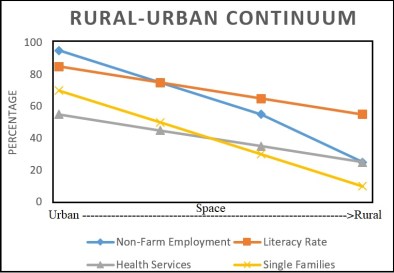The concept of Rural-Urban Continuum has been given by R.E. Pahl. This concept refers to the gradation of life between urban and rural areas. We use the word ‘continuum’ when there is no strict boundary between two areas. Therefore, rural-urban continuum denotes that there is no clear and distinct boundary between rural and urban areas’ characteristics.
Definition: Rural-Urban Continuum refers to the physical space or land over which the urban socio-economic and cultural characteristics diminish slowly from the city towards the rural areas.
Difference Between Rural & Urban Areas
Rural and urban areas have different ways of life. The way of life does not only refers to the type of settlement but also to the social, cultural and economic characteristics of an area. The differences between rural and urban way of life is as following.
- People in the rural areas of India use mud, straw, cow dung etc. for construction of their homes. However, urban dwellers use more bricks, cement, concrete etc. It means that urban houses are stronger and modern in relation to rural settlements.
- Agriculture is the mainstay of the rural economy. As per Census of India (2011), industry and service sectors are the main employment providers of the urban areas.
- The density of population in urban area is generally greater than 400 persons/sq². Whereas, it is lesser in rural areas. The total size of population is many times greater in an urban settlement than the rural areas.
- The health, educational, entertainment, marketing amenities are primarily superior in urban settlements than the rural ones.
- It is also seen than the rural areas have traditional ways of life. For instance, rural dwellers live in joint families where the women, primarily, take care of domestic work and men go out to work for earning livelihood.
- There is significant differences in the dress, food and habits of the rural and urban dwellers.
Given the above differences, one may assume that there is a strict boundary between rural and urban areas with regards to these characteristics but it is not the case.
Rural-Urban Continuum: A Sociological Concept
Rural-Urban Continuum is a different concept than the Rural-Urban Fringe.

Rural-urban continuum is a sociological concept which lays more attention on the way of life, dress, language, food etc. Contrarily, the rural-urban fringe lays more attention on land-use and less on the way of life. Fringe is more of practical concept for town planners who divide land into different parts for urban development policies.
The rural-urban fringe is a dividing term. It denotes the area surrounding a city as different and separate from the city and villages. The fringe is an area around a city having both rural and urban character. Whereas the continuum is a binding concept which denotes that rural and urban areas are part of a spectrum of characteristics (see Fig. 1).
In Indian Context
This concept is derived from the experience of the western countries. Therefore, it has little application in India’s context.
- In India, urbanism is present in villages and rural lifestyle is present in cities. For example, one can easily see huts in cities as well as the villages of India. Poor people generally build small huts in slums of cities.
- It is a saying that Indian cities have urban buildings but rural people. It is so because the people in cities of India follow rural moralistic code related to religion, caste, class, gender etc. For instance, most of the workers in the cities are still men and women continue to serve at homes. Similarly, there is spatial segregation of residences based on caste in Delhi and Mumbai.
- The municipal rules are not vigorously implemented in Indian cities. Therefore, people indulge in dairying and farming within city limits.
- In today’s world of swift modes of transport and communication, the urban ideas, dressing style and way of life is spreading fast to rural areas. Hence, differentiating both is very difficult.
In this context, we can argue that the way of life in cities in India is very close to the way of life in villages.
Conclusion
To sum up, we can say that the rural-urban continuum is an abstract concept which denotes that cities and villages are spatially integrated by a spectrum of characteristics. However, this concept has little practical application in policy design and implementation.
Kulwinder Singh is an alumni of Jawaharlal Nehru University, New Delhi and working as Assistant Professor of Geography at Pt. C.L.S. Government College, Kurukshetra University. He is a passionate teacher and avid learner.
